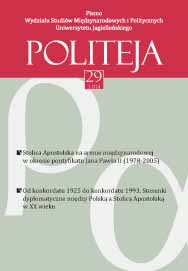Polityka konkordatowa Stolicy Apostolskiej ze szczeg ólnym uwzgl ędnieniem kraj ów Europy Środkowej i Wschodniej
The concordat policy of the Holy See with special reference to the countries of Central and Eastern Europe
Author(s): Tadeusz PieronekSubject(s): Politics / Political Sciences
Published by: KSIĘGARNIA AKADEMICKA Sp. z o.o.
Keywords: concordats; Vatican diplomacy; Church–state relations; The Holy See; ecclesiastical law; John Paul II; Central‑Eastern Europe
Summary/Abstract: The beginnings of the concordat policy of the Holy See, the changes in the Codex of Canon Law which took place after the First World War. The period in which many countries broke agreements with the Holy See. This period began ca. 1922 due to the emergence of the United Soviet Socialist Republics and all of the countries which were subordinate to it after the Second World War. The regulations of mutual relations between the Catholic Church and the state, which was used to be set out in concordats and international agreements, was replaced by state legislation of various standards, and the administrative supervision over all of the religious denominations was entrusted by passing an act of law was entrusted to the Office of Religious Denominations. The latter was furnished with broad, almost dictatorial competences. In such difficult times the Catholic Church experienced one of the most important events in the 20th century – the Second Vatican Council (1962‑1965) – four years of hard work and epochal deliberations about the Catholic Church and its mission in the world. The thinking of the council is contained in the entire doctrinal and pastoral output of the Council, especially in four of its documents: in the Decree about The pastoral task of the bishops in the Church “Christus Dominus”, in the Dogmatic Constitution On the Church “Lumen gentium”, in the Declaration On Religious Freedom “Dignitatis humanae” and in the pastoral Constitution On the Church in the modern world “Gaudium et spes”. The Second Vatican Council was not directly engaged in bilateral agreements with states, but after the council was over there were executive acts which regulated this area of concern. The Codex of Canon Law of 1983 was one of the more important documents of this kind. Ostpolitik – i.e. the eastern policy of the Holy See. The Vatican Diplomacy was faced with the great and difficult task of providing assistance to the Catholic Church in the countries of the Soviet bloc through the establishment of contacts with communist governments. Here there is a description of efforts made by successive representatives of the Holy See directed toward the propagation of religious freedom and human rights, mainly in the countries of Central‑Eastern Europe. The events associated with the Concordat of Poland with the Holy See were crucial not only for the parties involved in it, but it was also the first solemn act of collaboration between the Vatican and a postcommunist country. At the same time other Central‑Eastern European countries took a similar course whose aim was to achieve normalization in the relations with the Church. Nowhere was this course easy.
Journal: Politeja - Pismo Wydziału Studiów Międzynarodowych i Politycznych Uniwersytetu Jagiellońskiego
- Issue Year: 11/2014
- Issue No: 29
- Page Range: 147-177
- Page Count: 31
- Language: Polish

